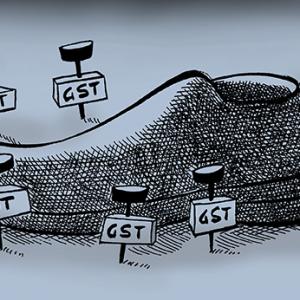Currently, 23 power units with a cumulative capacity of 30,000 MW have super critical coal stock situation
A lack of synchronised approach between the concerned ministries and power plants, has led to this crisis, says Shreya Jai.

One of the major promises of the Bharatiya Janata Party government when it came to power in 2014 was to be ‘coal surplus’ by increasing production and improving supply.
State-owned monopoly Coal India was given a tall target of 1 billion tonnes of coal production by 2019; three arterial railway lines were started from Odisha, Jharkhand, and Chhattisgarh; and a plan was drafted to increase the number of railway rakes for coal supply to power units.
CIL ramped up production by opening new mines.
So much so that one of its subsidiaries CCL was opening a new mine every month last year.
This boosted the government’s confidence, and it then started the programme of reducing dependence on imported coal to nil. This is where the problems began.
During the last fiscal year, while CIL was increasing coal production to record levels, takers for its coal and the amount of coal dispatched reduced.
Financially beleaguered power distribution companies, which weren’t buying surplus power, are still not doing so.
This led to power plants running at low capacity, thereby impacting the demand for coal.
Demand was so low that the ministry of coal rounded up close to 30 power generating units last year to pay penalties for sourcing coal below their lowest permissible threshold, a senior official told Business Standard.
At the same time, State-owned NTPC started reducing its import dependence.
NTPC typically blends 8-10 per cent of imported coal in case of a domestic supply crunch.
The thermal power behemoth running 49,000 megawatt (MW) of coal-based units “reduced imported coal consumption by 85 per cent, compared to the previous year,” Gurdeep Singh, chairman and managing director, NTPC, told shareholders in his speech at the annual general meeting.
The increased demand was met by CIL pushing dispatches to NTPC.
Private units, even those in western India which were dependent on imported coal, asked for more coal from Coal India.
In August, coal imports at Indian ports fell by 14 per cent over the last year to nine million tonnes.
“But at the same time, the dispatches to captive power plants (CPP) reduced. In the last eight months, the backlog of rakes is close to 900 for captive units,” said an executive with a medium-sized industrial unit running a CPP. A CPP produces power for its own use.
CIL officials, on the other hand, kept emphasising that the private units were running at low capacity, hence dispatches to them were less.
Meanwhile, the crucial Dhanbad-Chandanpura railway line broke down and is still under repair. The three planned lines are yet to be fully operational.
Peak summers precipitated the crisis with Uttar Pradesh being the first to complain that it is only NTPC which is being supplied coal and State-run and private units are facing a scarcity.
Next in line came Maharashtra and Rajasthan, which had the same issue and the latter succumbed to power cuts.
By August, the situation worsened with hydropower generation below the optimum capacity due to a weak monsoon.
Marred with payment issues and regulatory confusion, wind power faced its worst production year at 354 MW during April-August 2017.
Average coal stocks at power plants by September-end were at a record low of five days.
Last year, in the same month, the figure was 28 days.
The number of rakes carrying coal for the power sector was increased by the rail ministry.
But this led to other sectors such as steel, cement and captive power units complaining of diversion of their rakes for power plants.
As the situation stands now, the ministry of coal has gone on record with the counter that it is the power plants which should have kept a certain stock of coal at their sites.
Power plants, however, are alleging mismanagement by the ministries involved -- coal, power, and railways. A lack of synchronised approach, they said, has led to this crisis.
Currently, 23 power units with a cumulative capacity of 30,000 MW have super critical coal stock situation, as per the Central Electricity Authority.
Latest data from ports show that, after five months of straight decline, coal imports have shown a spurt to 18.33 million tonnes.
The headlines have gone back to coal deficit.
Earlier, states would blame the Centre, the Union power ministry would blame the coal ministry, and the coal ministry would blame railways.
For a government that vowed to break down silos, this is the test of cooperative federalism that it claimed to reinstate.
Photograph: Ajay Verma/Reuters.










